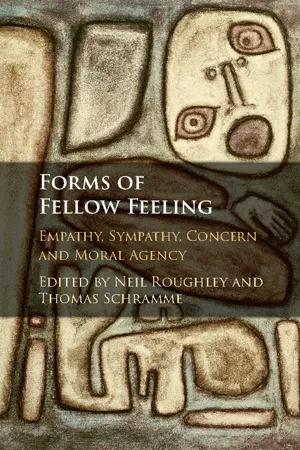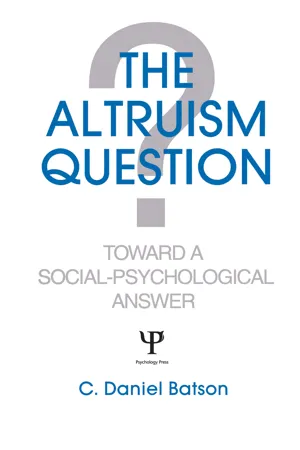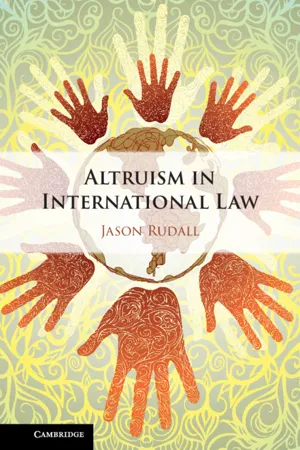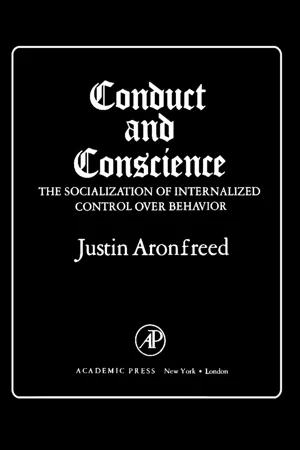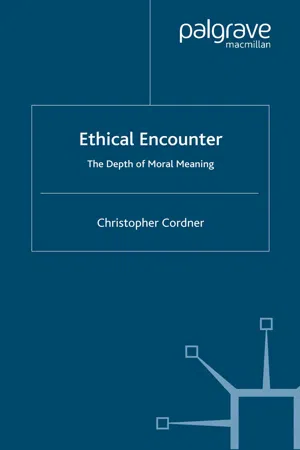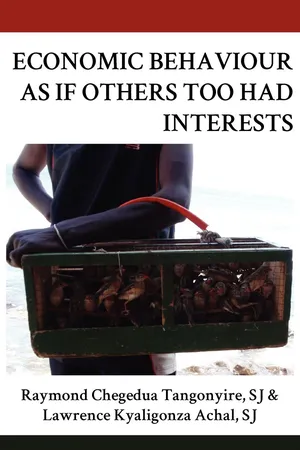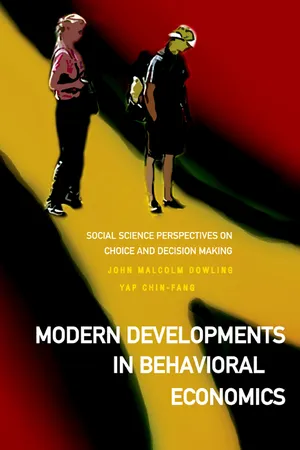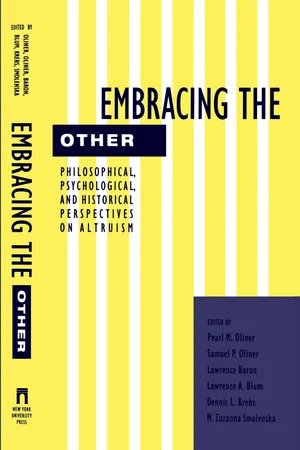Psychology
Altruism Psychology
Altruism in psychology refers to the selfless concern for the well-being of others. It involves acts of kindness and generosity without expecting anything in return. Psychologists study altruism to understand the motivations and underlying mechanisms that drive people to help others, and its impact on individual and collective well-being.
Written by Perlego with AI-assistance
Related key terms
1 of 5
11 Key excerpts on "Altruism Psychology"
- eBook - PDF
Forms of Fellow Feeling
Empathy, Sympathy, Concern and Moral Agency
- Neil Roughley, Thomas Schramme(Authors)
- 2018(Publication Date)
- Cambridge University Press(Publisher)
Using this definition, evolutionary biologists can speak of altruism across a very broad phylogenetic spectrum, ranging from social insects to humans. But as Sober and Wilson (1998) pointed out, it is important to distinguish between evolutionary altruism and psychological altruism. Evolutionary altruism is behavior that reduces one’s reproductive fitness. Psychological altruism is motivation with the ultimate goal of increasing another’s wel- fare. Evolutionary altruism is neither necessary nor sufficient to produce psychological altruism. The empathy-altruism hypothesis concerns psy- chological altruism. Altruism as helping in order to gain internal rather than external rewards. Other scholars define altruism as a particular form of helping – helping in order to gain internal rather than external rewards. This use does consider the motivation for benefiting others, but it reduces altru- ism to a special form of egoism. By this definition, which is common among behavioral economists (see Fehr and Zehnder 2009), benefit- ing another as a means to benefit oneself is altruism as long as the Empathy, Altruism, and Helping 67 self-benefits are internally rather than externally administered. If you help someone in need in order to gain a good feeling (e.g., a warm glow), to avoid guilt, or to reduce your distress caused by witnessing his or her suffering, then your motivation is altruistic. By the definition used in the empathy-altruism hypothesis, these ultimate goals are not altruistic. They are forms of egoism. Back to the Hypothesis With this explication of the terms “empathic concern” and “altruistic motivation,” we can state the empathy-altruism hypothesis more pre- cisely. - eBook - PDF
- Eva Kahana, David E. Biegel, May Wykle, Eva Kahana, David E. Biegel, May Wykle(Authors)
- 1994(Publication Date)
- SAGE Publications, Inc(Publisher)
Altruism often is equated with helping but is not, in actuality, always coterminous with helping. It even may be argued that there are instances in which the most altruistic course of action is to desist from helping despite one's own urges to do something in response to neediness (Brickman et al., 1982; Midlarsky & Hannah, 1985). According to A. Comte, who has been credited with coining the term, altruism is consid-eration, concern, and affection for other people as opposed to self-love or egoism. Altruistic acts, in turn, are characterized by constructive consid-eration and interest in others (Wolman, 1973). When helping results from altruistic—or other—motives, it can take various forms. The two studied most frequently by altruism researchers are sharing of resources, also termed generosity or charitableness, and rescue. A third, nurturance, is more directly concerned with caregiving in the family context. In addition to the focus on the other, the term altruism is reserved for helping that, although costly for the helper, is not performed because the actor expects extrinsic rewards or reciprocation, because it is man-dated by one's social roles, or because of coercion by others. The benefactor chooses to act because of the desire to benefit another, whatever the cost to oneself. Indeed, an important determinant of helping—particularly unreciprocated helping—is the perceived depen-dency of others for reasons of illness or disability. This is not to say that helping ultimately must be entirely unreward-ing in order to be considered altruistic. People who generally care for and about others may reap diverse benefits, albeit benefits that are 72 PARADIGMS FOR CAREGIVING subtle and not directly sought. - eBook - ePub
The Altruism Question
Toward A Social-psychological Answer
- C. Daniel Batson(Author)
- 2014(Publication Date)
- Psychology Press(Publisher)
pseudoaltruistic; they are really egoistic, not altruistic.Pseudoaltruistic Approaches
Pseudoaltruistic approaches to the question of why we help others can be classified into the following three types.Altruism as Helping Behavior, Not Motivation. First, there are researchers who ignore the issue of motivation altogether, equating altruism with the act of benefiting another organism relative to oneself (i.e., helping). This first pseudoaltruistic approach has been popular with developmental psychologists, especially those studying children from a social learning perspective (see Rushton, 1980, for a review). It has also been popular with sociobiologists, who wish to apply the term altruism across a very broad phylogenetic spectrum—from the social insects to man (Dawkins, 1976 ; Hamilton, 1964 , 1971; Trivers, 1971 ; Wilson, 1975 ).To illustrate this approach, consider the definition of altruism employed by sociobiologists Ridley and Dawkins (1981 ):In evolutionary theory, altruism means self-sacrifice performed for the benefit of others. In everyday speech the word altruism carries connotations of subjective intent.... We do not deny that animals have feelings and intentions, but we make more progress in understanding animal behavior if we concentrate on its observable aspects. If we use words like altruism at all, we define them by their effects and do not speculate about the animal's intentions. An altruistic act is one that has the effect of increasing the chance of survival (some would prefer to say "reproductive success") of another organism at the expense of the altruist's.... It follows that an indubitably unconscious entity such as a plant, or a gene, is in principle capable of displaying altruism. (pp. 19-20) - eBook - PDF
- Jason Rudall(Author)
- 2021(Publication Date)
- Cambridge University Press(Publisher)
9 Ibid., 79. 10 C. Daniel Batson, The Altruism Question: Toward a Social Psychological Answer (Lawrence Erlbaum Associates, 1991), 6; Andrew Michael Flescher and Daniel Worthen, The Altruistic Species: Scientific, Philosophical, and Religious Perspectives of Human Benevolence (Templeton Foundation Press, 2007), 35. 11 Vincent Jeffries, ‘Altruism, Morality, and Social Solidarity as a Field of Study’ in Vincent Jeffries (ed.), The Palgrave Handbook of Altruism, Morality, and Social Solidarity: Formulating a Field of Study (Palgrave Macmillan, 2014), 6; Vincent Jeffries, ‘Virtue and the Altruistic Personality’ (1998) 41 Sociological Perspectives 151. 12 Jacqueline Macaulay and Leonard Berkowitz, Altruism and Helping Behavior (Academic Press, 1970), 3. 13 John Philippe Rushton, Altruism, Socialization, and Society (Prentice Hall, 1980), 8. altruism 19 After reflecting on a variety of definitions from different fields, Andrew Michael Flescher and Daniel L. Worthen consider that altruism means acting in the interests or well-being of another. Moreover, they similarly place an emphasis on the fact that the intention should be to bring a benefit to another. They also observe that altruistic behaviour can result from a moral duty or may be supererogatory, and everyone is capable of acting altruistically. 14 Interestingly, as Kristen Renwick Monroe also highlighted, they note that altruism should involve a diminution in the welfare of the actor and an amelioration in the welfare of the beneficiary. This is in fact a recurring element in the scholarship on altruism across a variety of disciplines, to which we turn now. 1.2.2 Altruism Is Action for the Other at a Cost Altruism implies action or an intention to take action at some cost to the actor. - eBook - PDF
Political and Civic Leadership
A Reference Handbook
- Richard A. Couto(Author)
- 2010(Publication Date)
- SAGE Publications, Inc(Publisher)
An Overview of Theory and Research on Altruism There are two main sources of theory and research on altruism—evolutionary biology and psychology. Evolutionary biologists tend to define altruism in terms of the biological 74 A LTRUISM K ATHY D ENTON Douglas College, British Columbia D ENNIS L. K REBS Simon Fraser University, British Columbia 661 and genetic consequences of behaviors. Psychologists tend to define it either in terms of such psychological conse-quences of behaviors as pain and pleasure or in terms of the intentions of donors or helpers. The following sections provide a brief overview of research from each source, and then the implications for leadership are explored. A Brief Review of Biological Theory and Research on Altruism Charles Darwin (1874) considered evidence of self-sacrificial altruism in social insects potentially “fatal” to his theory of evolution. How, he wondered, could mecha-nisms that induced insects such as bees and ants to sacrifice their lives for the sake of their groups evolve through sur-vival of the fittest? Contemporary evolutionary biologists have offered several answers to this question. First, they have pointed out that individuals can propagate the genes that dispose them to behave in altruistic ways by increasing the reproductive success of kin who possess copies of these genes (Hamilton, 1964). For example, a gene for altruism could spread if a woman who was not capable of reproduc-ing (as is the case for most female members of social insect species), helped her sisters or brothers (who possess copies of her altruistic genes) reproduce. Second, evolutionary biologists have argued that altruistic individuals could fare better biologically than nonaltruistic individuals if they engaged in return-benefit forms of reciprocity that reaped gains in trade (Trivers, 1971). - eBook - PDF
The Ethical Dimension of Psychoanalysis
A Dialogue
- W. W. Meissner(Author)
- 2012(Publication Date)
- SUNY Press(Publisher)
This conclusion seems entirely consistent with the findings of analysis, and finds support in the universal human capacity for empa- thy—the empathic response to the distress of another can serve as a pow- erful motivator for helping behavior (Wright 1971). From an analytic perspective, altruism is found in both normal and pathological forms. Beth Seelig and Lisa Rosof (2001), arguing in favor of a concept of normal altruism, propose a spectrum of forms of altruism including protoaltruism, generative altruism, conflicted altruism, pseudoaltruism, and finally psychotic altruism. Protoaltruism is instinc- tual, biologically derived, and finds its modal expression in maternal and paternal nurturing and protectiveness. Generative altruism is based on nonconflictual pleasure in contributing to the success or welfare of another. When altruism becomes caught up in conflict, as in conflicted altruism, the satisfaction of another is still enjoyed but as a proxy. Pseudoaltruism takes this process a further step, acting as a defense against sadomasochistic motives and no satisfaction is taken in the suc- cess of the proxy. And finally, psychotic altruism is characterized by bizarre forms of delusional caretaking behavior and self-denial found in psychotic individuals. Anna Freud (1937) described “altruistic surrender” by which an indi- vidual, unable to achieve direct gratification of instinctual wishes, could do so vicariously through a proxy. She later (Sandler and Freud 1985) con- Object Love and Altruism 163 cluded that this was the basis of all altruistic behavior, so that the view of altruism as conflictual and compromise has prevailed among analysts. Seelig and Rosof (2001) see altruistic surrender as combining features of both conflicted altruism and pseudoaltruism. But other analysts have argued for a less conflictual and defensive altruism (Simons 1987; Vaillant 1977). Moreover, altruism must be considered in its cultural context. - eBook - PDF
Conduct and Conscience
The Socialization of Internalized Control Over Behavior
- Justin Aronfreed(Author)
- 2013(Publication Date)
- Academic Press(Publisher)
The usefulness of a concept of altruism is lost if we simply apply it to any be- havior of an animal that benefits another member of the species. We would then have to apply the concept to the extensive grooming behavior of many primates (DeVore, 1965), even though the grooming is reciprocal and is sometimes a source of edible insects for the groomer. Likewise, retrieval, cleaning, and other kinds of close contact with the young may have directly experienced pleasurable (or distress-reducing) consequences for the female adults of some species. The concept of altruism can be better employed, in reference to a distinct phenomenon, if we use criteria which restrict it to the situation in which the behavior of one individual is shown to be con- trolled by either the direct observation or the cognitive representation of its ALTRUISM AND SYMPATHY 141 consequences for another individual. Human beings may have a unique capacity for this type of control over their behavior. However, one would hardly want to treat altruism as being anything like a species-specific phe- nomenon in humans. It shows the great variation of occurrence and form that we can only attribute to corresponding variation in social experience. Aside from a few attempts to use verbal self-report as an index of a gen- eralized attribute or trait of altruism (Cattell and Horowitz, 1952; Fried- richs, 1960; Turner, 1948), most of the empirical work that might be re- garded as having any relevance to altruism consists of direct observation of dispositions to share possessions with peers or to extend aid to them. - eBook - PDF
Ethical Encounter
The Depth of Moral Meaning
- C. Cordner(Author)
- 2001(Publication Date)
- Palgrave Macmillan(Publisher)
(And not because such a focus may obscure the need for each person to have a healthy concern for himself: that thought is not at issue here.) This is so in two ways. First, a traditional emphasis on altruism is blank to the way in which an ethical orientation implicates – better, defines – the one compelled by it. If there is something important in the idea of a selfless generosity or compassion (though we have not yet explored just what this might mean), such an orientation can still be self-defining, and can be so without being in the least egoistic. Secondly, the concept of altruism affords too limiting a sense of the way in which others are most deeply present – we could also say most fully real – to one ethi- cally engaged by them. Someone’s orientation may satisfy the usual conditions of altruism yet still involve, in more than one way, an ethi- cally shallow sense of ‘the other’. The concept of altruism is inadequate to reflect a way in which others can be fully present to us. Being able to realize them as present in this way is a condition of the deepest ethical understanding. Altruism and Moral Meaning 47 My main interest in this and the next chapter is not in altruism and its limitations per se. It is in what an exploration of some of those limi- tations will help reveal both about our ethical relations with others – more precisely, about what it is for others to be fully present to us – and also about our own ethical self-realization through such encounter with others. These, it will be argued, are two interdependent dimen- sions of an ethical orientation that I said earlier we cannot but find ourselves under and that lies beyond Aristotle. I begin by discussing a relatively straightforward way in which someone’s ethical responsive- ness to others can be definitive of what he is, about which the concept of altruism is at best unhelpfully mute. As will be seen, the second of my two lines of critical reflection itself divides into two. - eBook - PDF
- Chegedua Tangonyire, Kyaligonza Achal, Lawrence(Authors)
- 2012(Publication Date)
- Langaa RPCIG(Publisher)
23 Chapter 2 Altruism When people do generous things such as voluntary work in refugee camps, guiding strangers, contributing to charities, and giving aid to victims of natural disasters, we quickly conclude that they are altruistic because for us altruism means acting in other people’s interests. There is nothing wrong with referring to generous and charitable people as altruistic but what we want to correct in this book is the illusion that such people are not influenced by some degree of self-interest. We want to emphasize the fact that all those so-called altruistic acts have some strings attached to them, the actors’ interests. Absolute Altruism Absolute or pure altruism means acting in the interest of other people at the expense of one’s own interests without expecting any benefit for oneself. 34 Acting in the interest of other people is what we referred to as the positive law of egoism . Let us refer to ‘acting at the expense of one’s own interests’ as the first degree of altruism and ‘acting without expecting any benefit for oneself’ as the second degree of altruism . Absolute altruism can only happen in a world of angels but not in a world of ordinary human beings like us. There is no such a thing as pure altruism or selflessness in our world. All human beings are motivated by some degree of self-interest. At best, some are motivated by a mixture of self-interest and altruism. True, some people do act in the interest of others and sometimes even at the expense of their own interests but nobody ever acts in the interest of others without expecting some benefit for himself. The expectation might be implicitly hidden but it is always there. Similarly, the cost of helping others might be higher than the benefit derived by the helper but, however little, that benefit is always there. The benefit can be material, psychological or spiritual. - eBook - PDF
Modern Developments in Behavioral Economics
Social Science Perspectives on Choice and Decision Making
- John Malcolm Dowling, Yap Chin Fang;;;(Authors)
- 2007(Publication Date)
- WSPC(Publisher)
You usually spend more time with family members or people you know well and you form close bonds with them; therefore, you tend to be more altruistic toward them. As your associations with others become more at arms-length, tendencies of altruism become weaker. One exception to this rule is the hero syn-drome. The fireman runs into a burning building to save a child. A soldier single-handedly risks almost certain death by attacking an enemy position or a bystander helps to detain a thief. 5.7 Nurturing Altruism Much altruistic behavior takes place in the context of social interaction. By reinforcing altruistic or cooperative behavior, beneficial social out-comes can be supported. In an interesting set of experiments, Ernst Fehr (2003) shows the effect of external approval or disapproval on altruistic behavior. Using social dilemma experiments with 283 college students, Fehr shows that altruism based on a sense of what is fair is a powerful source of human cooperation. Actions which are selfish or greedy destroy altruistic cooperation almost completely, while actions perceived as fair and unbiased leave altruism and cooperation intact. Fehr says this result is useful in situations wherever voluntary compli-ance is important such as between spouses, in the education of chil-dren, in business organizations, in markets and in environmental issues. It is also important in resolving problems of free riders and other situations where cooperation leads to desirable outcomes. 5.8 Free Rider Problems The general problem of free riding occurs in many different situations and leads to an inefficient level of production and consumption. The literature is replete with examples of the tragedy of the commons and moral hazard. However, these inefficiencies in production and 174 Modern Developments in Behavioral Economics consumption depend upon the assumption that agents maximize self-interest with regard to others. - eBook - ePub
Embracing the Other
Philosophical, Psychological, and Historical Perspectives on Altruism
- Pearl Oliner, Samuel P. Oliner, Lawrence Baron, Lawrence Blum, Pearl Oliner, Samuel P. Oliner, Lawrence Baron, Lawrence Blum(Authors)
- 1992(Publication Date)
- NYU Press(Publisher)
say they have emitted or would emit. Though the range of behaviors assessed in self-report tests tends to be broader than the range of behaviors assessed in lab-based research (it is easier to ask people what they would do or what they have done in various situations than to expose them to the situations and see what they actually do), they nonetheless fail to constitute a representative sample of the types of helping behavior engaged in by the different types of people (e.g., males and females, young people and old people) who take the test. Each incident of helping is given the same weight—that is, all are considered equally altruistic. Self-report measures fail to assess the motives guiding the helping behaviors subjects report, and they fail to distinguish between the quality of altruism intrinsic to different acts. Was the stranger in need an unattractive member of the same sex or an attractive member of the opposite sex? Whose needs were fulfilled by the prosocial overture?Methodologically, the psychometric approach suffers from the well-known limitations of self-report measures. Unfortunately, people are not very dependable sources of information about themselves (see Gelfand and Hartmann 1982; Krebs et al. 1989). Thus, it is not really surprising that pencil-and-paper tests of altruism fare poorly on accepted criteria of validity. For example, the Rushton, Chrisjohn and Fekker test correlated only .21 with peer ratings (.33 when corrected for attenuation), and there is no evidence that individuals to whom altruistic personalities are attributed on the basis of behavioral consistency also are defined as altruistic on the basis of scores on personality tests.
Index pages curate the most relevant extracts from our library of academic textbooks. They’ve been created using an in-house natural language model (NLM), each adding context and meaning to key research topics.
